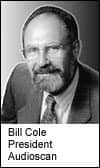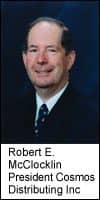From Denmark to the United States—and soon Vietnam—Sonion keeps growing, creating miniature components along the way.

The dictate that “smaller is better” is common in the world of hearing aids, and at least one Sonion employee agrees. “If we had larger ears, we could make larger hearing instruments and larger components, and we could create even better performance,” says Ken Teese, product manager of sub-miniature transducers at Sonion. “As you go smaller, you run into the walls of physics at times, and you have to overcome that obstacle and figure out how to make a better-performing transducer in a smaller package.”
No Small Task
To many nonengineers, the prospect of designing components that are smaller and perform better than previous models is anxiety-producing at the least and mind-numbing at the most. But ask Teese about the everyday challenges he and the Sonion R&D department face in packing more and more performance into a tinier package and his friendly, professional tone changes to excitement. “That’s the fun part, in my opinion,” Teese says. “To be able to look forward and figure out ‘What should we be doing?’, ‘What could we be doing?’, and what the next design will be.”
At Sonion, the first step toward a new design is often a dialogue between the company and its customers in the hearing aid manufacturing industry. Sometimes, manufacturers will approach the company with a problem and ask for a resolution; at other times, Sonion will choose an existing product and try to improve it.
The creation of Sonion’s 3000 series receivers, the company’s latest line, was motivated by the desire to make a better receiver for the behind-the-ear (BTE) and in-the-ear (ITE) hearing instrument markets. Sonion’s established 1900 series receivers, for instance—designed to serve the BTE and ITE markets—needed more SPL output and frequency bandwidth, without increasing its overall physical size.

Eventually, the desire to build an improved receiver would result in the creation of two units that comprise the 3000 series: the 3100, a completely new offering, and the 3300, which is composed of two 3100 receivers assembled front to front. The 3000 series has been available to companies in the hearing instrument and in-ear monitor markets since 2005.
The Sum Of The Parts
During the initial design stages for the 3000 series, Sonion decided to create a product that would appeal to the high-power BTE market, as well as the ITE market. When its engineers went to the drawing board, they considered the parts of the receiver individually: the diaphragm, the armature, the magnets, the coil, and the assembly. Isolating each part, the engineers could fine-tune these smaller pieces that would be critical to the new receiver. 
“The market demands receivers to have more output over a broader frequency range while reducing mechanical vibration across all frequencies,” he says.
Initially concentrating on the motor assembly, after 12 months of development, Sonion released a limited beta version of the new receiver to its customers. Those hearing aid companies then built hearing instruments using Sonion’s new receiver, tested them, and returned to Sonion with the results.
The consensus from that study was for Sonion to increase bandwidth. The motor construction is now designed to extend the frequency response curve. The E-shaped armature provides high saturation level and excellent vibration properties to create a receiver with a high output capability and large bandwidth. The overall design of the 3000 series creates a better balance between physical size and audiological performance that is suitable for all modern digital signal-processing instruments. The technical aspect of the receiver is based on the theory of predictable vibration, where multiple modes of vibrations build on each other like ocean waves. All moving in the same direction across the balanced armature receiver, the vibrations travel in a motion parallel to the diaphragm.

Two 3100 receivers were assembled front to front to create the 3300 that cancels vibrations, decreases feedback by approximately 40 dB, and reduces the need for tweaking during manufacturing. Today’s hearing instrument manufacturers want more gain before feedback from their devices. Many times manufacturers and audiologists are required to tweak frequency responses for users with feedback-eliminating software. Much of that extra work and anxiety can be alleviated with Sonion’s 3300 receiver.

Recently, Sonion also introduced a new microphone line, the 6200 series, at the AudiologyNOW! 2006 convention in Minneapolis. Similar to the 3000 series, all of the changes in the microphone series’ design were internal. Engineers maximized the thickness of the diaphragm and changed air gap differences as well as tension on the diaphragm. Sonion also added a new circuit. These microphones are 40% smaller than their predecessor, Sonion’s popular 9000 model, but are just as sensitive with low output noise.
During the past few years, there has been a trend toward directionality, the feature that requires more than one microphone or a special single-cartridge directional microphone. Smaller units have helped make this possible as customers demand the ability to pick out a specific sound among many, such as hearing an individual person speak even when the conversation takes place in a crowded and loud room.
As the digital age has arrived in the hearing aid industry, receivers that are designed to interface with the outputs of digital devices are just a few of the products on which Sonion is working. The company is also working to create new ways to improve hearing instruments for open ear applications, Teese says.
Jorgen Broberg, marketing manager of Sonion’s Hearing Component Division, is also interested in the nontechnical demands of the hearing impaired community, such as the stigma attached to wearing hearing aids. Broberg believes that this stigma motivates Sonion to make smaller components even smaller, so that tinier, tougher-to-detect hearing aids can be built.

Sonion’s roots date back to the 1880s when the first Danish telephones were developed. Emil Moeller’s Telefonfabrik (later called Kirk Acoustics) was the first facility in Denmark to manufacture telephones.
Sonion is the result of a 2000 merger between a component supplier to the hearing instrument market, Microtronic, and Kirk Acoustics. Kirk Acoustics operated in the component market for mobile terminals and was planning to also cover headsets by offering receivers. “[Through] the merger with Kirk Acoustics, we had formed a unique combination, bringing together expertise in micro-acoustics, micro-mechanics, and mass production capabilities,” says Jeff Taylor, president of Sonion US Inc. “We can now fulfill an even wider spectrum of demands, building on great potential for convergence of technology.”
Sonion established itself in the United States in 1996, with headquarters in Minnetonka, Minn.
With the 2004 acquisition of AKG’s telecom division completing the group, Sonion is currently run as a matrix organization with three business units: hearing instrument components, mobile terminal components, and medical device components.
While Sonion’s engineers work to meet the demands for smaller components, the company itself continues to grow. Currently, Sonion has 3,000 employees worldwide who work in the United States, Denmark, Poland, Netherlands, and China. Vietnam is the latest to be added to that list. Sonion is in the process of building a new production facility there. If all goes according to plan, the first of Sonion’s many “small things” will start to be produced out of a very large factory later this year.
Stephen Krcmar is a contributing writer for Hearing Products Report.




